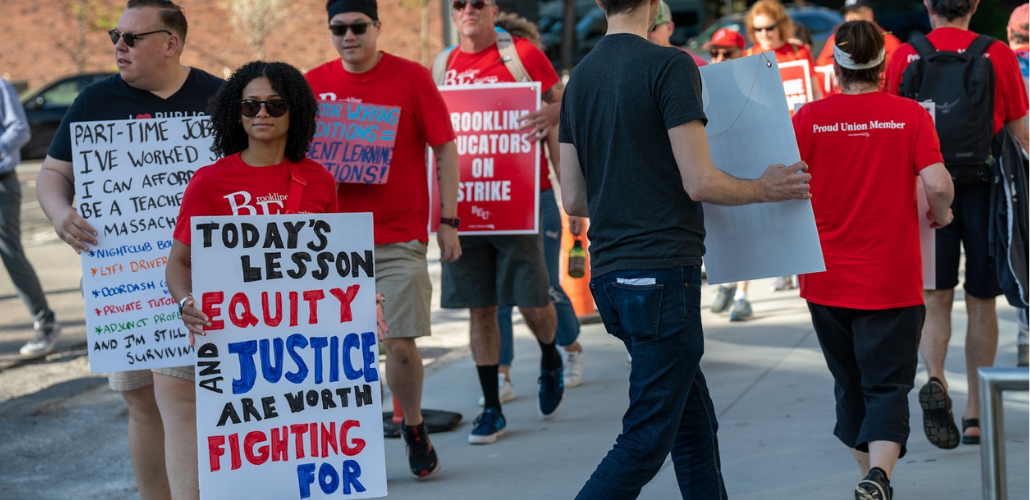How Educators in Brookline, Massachusetts, Won an Illegal Strike

Striking has been illegal for public employees in Massachusetts since 1919. But that didn't stop them in Brookline, a small suburb of Boston, where educators won nearly all their demands after they walked out on May 16. Photo: Massachusetts Teachers Association
Striking has been illegal for public employees in Massachusetts since 1919. But in Brookline, a small suburb of Boston, we did it anyway.
Out of a membership of 1,100, more than 900 signed in on the picket lines May 16. The strike culminated with a thousand educators descending on town hall for a rally with allies from around the state.
VIDEO: More on the Brookline Strike
Brookline Educators Union President Jessica Wender-Shubow spoke in the Sunday Main Session at the 2022 Labor Notes Conference about the lessons of the strike. Watch the video.
Our bargaining team negotiated into the early hours of the next morning. When the sun rose, we had won two back-to-back three-year contracts with guaranteed prep periods for all educators, a fair pay raise including important changes to longevity structures, and language aimed at attracting and retaining a more diverse workforce.
In short, we won all our demands with minimal compromise. Perhaps more important, we ended a cycle of disrespect and showed that we are willing to take collective action.
“I think that elected officials will think twice about messing with the teachers, now that they saw what we could do by sticking together,” said school librarian Dominique Gonyer, “The school committee made themselves look bad to the voters, and public opinion shifted in our favor.”
LIFTING THE CURTAIN
To understand how the Brookline Educators Union built the capacity to break the law and strike, you have to look back a few years. Since 2016, we’ve been through two superintendents and three interim superintendents—the result of rash attempts to impose an untenable “data-driven” model of schooling on educators and students.
Despite all the turnover, the school committee (like a school board) was steadily growing more combative during negotiations. To expose this behavior, we pushed to open bargaining to members and the public. In 2019, we won a step in that direction: the right to have 12 “silent representatives” at the bargaining table.
Throughout the bargaining process from 2019 to 2022, more than 100 rank-and-file members served as silent representatives, bearing witness to management’s blatant bad-faith bargaining.
“I witnessed the aggressive demeanor, tactics, and commentary of the school committee’s lawyer,” said social studies teacher Susan Balogh. “That’s when I knew I had to join the contract action team.”

SUPPORT LABOR NOTES
BECOME A MONTHLY DONOR
Give $10 a month or more and get our "Fight the Boss, Build the Union" T-shirt.
“[Being a silent rep] gave me tremendous appreciation for how difficult it was to be on the negotiations team, and I no longer questioned them,” said math teacher Meghan Kennedy-Justice, “If, in their judgment, we needed a work action—whatever it might be—I would support them.”
RAMPING UP TO STRIKE
In spring 2021, the school committee proposed a 0 percent raise for the 2020-21 school year. They came back in September 2021 with slightly more money, but proposed to weaken our grievance rights and added a demand for a 30-minute longer workday without additional pay.
Meanwhile we were proposing fair cost-of-living adjustments, stronger measures to attract and retain educators of color, a planning period for every educator every day, and a joint committee to expose inequities and excesses in job expectations.
The school committee ignored these proposals and offered no counters—then forced us into state mediation by claiming impasse.
We had already been doing work-to-rule action, a canvassing campaign, visibility rallies, and leafleting. When mediation started in March, we realized it was time to ramp up. We shifted the role of our contract action team to coordinating a broader action team of 200 highly engaged members.
We mapped out an action escalation including a public rally, attending a meeting of the select board (like a city council) to demand funding, and packing the school committee meeting to give testimony showing our outrage.
Through these actions members began to feel that this wasn’t just another contract fight—we were out to break a cycle of fear and disrespect.
PERSONAL OUTREACH
Leading up to the strike vote, we had just a week to reach 1,100 members. We used a central spreadsheet to track how ready each person was to vote yes. Math teacher Julie James said, “With each communication I understood that the personal contact from me was different than getting an email.”
We identified building leads to keep in touch with strike headquarters and picket captains who would stay in touch with 10 members apiece, and we created cross-building partnerships. It all paid off—renewing my faith that when we fight we can win!
Maggie Canniff is a kindergarten teacher and co-chair of the contract action team.






You must log in or register to post a comment.